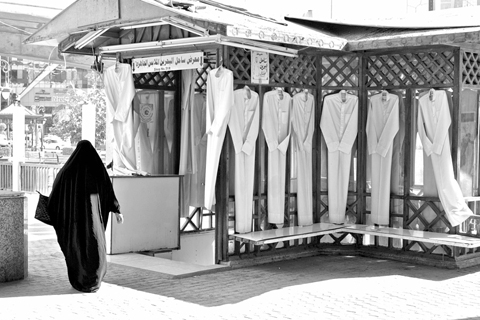Kuwaitis do not want to scare away winter, as they superstitiously believe that winter will flee once people are seen wearing heavy clothes.
 Readymade dishdashas shopfront. — Photo by Dr.Moayad H. Hussain
Readymade dishdashas shopfront. — Photo by Dr.Moayad H. Hussain
The weather in Kuwait these days is puzzling. Winter is not officially here, but the climate is definitely getting cooler and becoming a topic of daily conversations. Is it time to open those suitcases we packed with winter clothes last year, or should we wait till temperatures fall further?
In Kuwait, men prefer to wear dishdashas of lighter colors during summertime, while they wear dark-colored dishdashas in winter. Dishdasha, thobe, jalabiya and kandora are different terms for the long-sleeved Arabian garment men wear.
In the short autumn period when it's still warm but cooling down, some men get teased by their peers and families for wearing their winter garments too soon. Some men will even prefer feeling cold to avoid the mocking. Elderly people are more understanding of the need to protect themselves from the cold, because of their health.
The reason behind this joking is that some Kuwaitis do not want to scare away winter, as they superstitiously believe that winter will flee once people are seen wearing heavy clothes. Yaqoub Al-Towaitan said people long for winter and rejoice in its arrival. "We want our bodies to feel the cold, therefore we shouldn't hide ourselves from it," he said. His compatriot Nasser Sulaiman had another explanation. "Kuwaitis love to make sarcastic comments and jokes - we leave no one untouched," he said jokingly.
Designs
There are various designs of dishdashas in the Arabian Peninsula. In Kuwait, for instance, the garment went through several stages. "Before oil was discovered, our dishdasha resembled the shape of the Emirati garment to a large extent. There was no collar. Then, a classic collar was added after the oil boom that made it look like a shirt," explained Sulaiman. This design was fashionable for almost 30 years. "I still wear a dishdasha with a classic collar. I really like it. I believe it reflects the genuine soul of Kuwait," said Rajab Al-Shatti.
Another design appeared in the 1970s, but it didn't survive for long. It was called the mokhassara (slim fit). The quick disappearance of this garment wasn't surprising, because dishdashas are meant to be loose, comfortable and hide body imperfections.
Colors
The most popular color among the elderly is called dimi (identical to the color of tea with milk). Popular dishdasha colors are navy, gray, ocean blue and brown. But two old colors are now making a solid comeback.
"There's a high demand now for dark maroon and dimi among younger buyers," noted Mohammed Al-Turfi, who has been working at the Nasser Kakoli fabric shop in Souq Al-Mubarakiya for nearly seven years. "Men buy Chinese and Indian cashmere for everyday dishdashas, but they prefer British and European fabrics for the workplace and special occasions, as they're of a nicer quality. The great variety and quality we have in Kuwait attracts buyers from around the Gulf," Turfi added.
The Kuwaiti dishdasha design has gained fame in the Gulf states, and many tailoring shops offer it to their customers. In general, the dishdasha maintains its position as the main sartorial choice for local men in the Gulf region despite the openness of the youth to Western styles. They are proud of their inherited traditional attire, which is not anticipated to become extinct anytime soon, at least in this century.
By Athoob Al-Shuaibi










